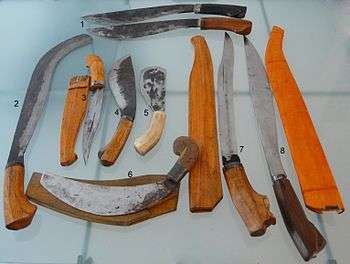Bolo knife
| Bolo | |
|---|---|
|
A typical bolo from Luzon | |
| Type | Knife |
| Place of origin |
|
| Service history | |
| Wars | Philippine Revolution, Philippine-American War, World War II |
| Specifications | |
| Blade type | Single-edged, convex blade |
| Hilt type | hardwood, carabao horn |
| Scabbard/sheath | hardwood, carabao horn |
A bolo (Tagalog: iták; Cebuano: sundáng; Hiligaynon: binangon) is a large cutting tool of Filipino origin similar to the machete. It is used particularly in the Philippines, the jungles of Indonesia, and in the sugar fields of Cuba.
The primary use for the bolo is clearing vegetation, whether for agriculture[1][2] or during trail blazing. The bolo is also used in Filipino martial arts or Arnis as part of training.[3][4][5]
Common use
The bolo knife is common in the countryside due to its use as a farming implement. As such, it was used extensively during Spanish colonial rule as a manual alternative to ploughing with a carabao. Normally used for cutting coconuts,[1] it was also a common harvesting tool for narrow row crops found on terraces such as rice, mungbeans, soybeans, and peanuts.[6] Because of its availability, the bolo became a common choice of improvised weaponry to the everyday peasant.[7]
Design

Bolos are characterized by having a native hardwood or animal horn handle (such as from the carabao),[8] a full tang, and by a steel blade that both curves and widens, often considerably so, at its tip.[1][5] This moves the centre of gravity as far forward as possible, giving the knife extra momentum for chopping.[8]
So-called "jungle bolos", intended for combat rather than agricultural work, tend to be longer and less wide at the tip.[1][5]
Bolos for gardening usually have rounded tips.[8]
Types
Various types of bolos are often employed for different purposes (see photo at right):
- The all-purpose bolo: Used for all sorts of odd jobs, such as breaking open coconuts.
- The haras: Similar to a small scythe, it is used for cutting tall grass. It is called "Lampas" by people from Mindanao.
- The kutsilyo: The term comes from the Spanish word cuchillo ("knife"). Generally used to kill and bleed pigs during slaughter.
- A smaller bolo.
- The bolo-guna (or simply guna): A bolo specifically shaped for digging out roots and weeding.
- The garab: Used to harvest rice.
- A large pinuti: Traditionally it is tipped in snake, spider, or scorpion venom and used for self-defence.
- The sundang (also "tip bolo" or "iták"): Supposedly used mainly to open coconuts, the sundang was a popular weapon of choice in the Philippine Revolution against the Spanish Empire and during the subsequent Philippine–American War.
Historical significance
The bolo was the primary weapon used by the Katipunan during the Philippine Revolution.[5][9] It was also used by the Filipino guerrillas and bolomen during the Philippine-American War.[1][2][5][10]
.jpg)
During World War II, the 1st Filipino Regiment was called the Bolo Battalion and used bolos for close quarters combat.[5][11]
.jpg)

On 7 December 1972, would-be assassin Carlito Dimahilig used a bolo to attack former First Lady Imelda Marcos as she appeared onstage at a live televised awards ceremony. Dimahilig stabbed Marcos in the abdomen several times, and she parried the blows with her arms. He was shot dead by security forces while she was taken to hospital.[12][13]
Symbolism
The bolo serves as a symbol for the Katipunan and the Philippine Revolution, particularly the Cry of Pugad Lawin. Several monuments of Andres Bonifacio, as with other notable Katipuneros, depict him holding a bolo in one hand and the Katipunan flag in the other.[9][14]
Other uses of the term
In the United States Military, the slang term "to bolo" – to fail a test, exam or evaluation, originated from the combined Philippine-American military forces including recognized guerrillas during the Spanish-American War and the Philippine-American War; those local soldiers and guerrillas who failed to demonstrate proficiency in marksmanship were issued bolos instead of firearms so as not to waste scarce ammunition.[15]
See also
References
- 1 2 3 4 5 Valderrama, Michael R. (22 June 2013). "The bolo". Sun.Star Bacolod. Retrieved 12 November 2014.
- 1 2 Mallari, Perry Gil S. (14 June 2014). "The Bolomen of the Revolution". The Manila Times. Retrieved 12 November 2014.
- ↑ Green, ed. by Thomas A. (2001). Martial Arts of the World. Santa Barbara, Calif.: ABC-CLIO. p. 429. ISBN 1576071502. Retrieved 12 November 2014.
- ↑ "Eskrima Martial Arts". Doce Pares International. 28 May 2014. Retrieved 12 November 2014.
- 1 2 3 4 5 6 Wolfgang, Bethge (2007). "The Bolo - An indispensable Utensil in the Philippine Household". Insights-Philippines.de. Retrieved 12 November 2014.
- ↑ Small Farm Equipment for Developing Countries: Proceedings of the International Conference on Small Farm Equipment for Developing Countries: Past Experiences and Future Priorities, 2-6 September 1985. Manila, Philippines: International Rice Research Institute. 1986. p. 314. ISBN 9789711041571.
- ↑ "Military Fighting Knives of the World". MilitaryItems.com. Retrieved 19 June 2013.
- 1 2 3 "Bolo Knife". Reflections of Asia. Retrieved 12 November 2014.
- 1 2 "Imprinting Andres Bonifacio: The Iconization from Portrait to Peso". Republic of the Philippines: Presidential Museum Library. 29 November 2012. Retrieved 13 November 2014.
- ↑ Dumindin, Arnaldo (2006). "Philippine-American War, 1899-1902". PhilippineAmericanWar. Retrieved 12 November 2014.
- ↑ Ruiz, AJ (13 July 2012). "Pinoy Patriots". Bakitwhy.com. Retrieved 12 November 2014.
- ↑ Fetherling, George (2001). A Biographical Dictionary of the World's Assassins (Unabridged. ed.). Toronto: Random House Canada. ISBN 0307369099. Retrieved 12 November 2014.
- ↑ "Profiling Imelda Marcos: 10 Reasons She’s Still Here". Oh No They Didn't!. ONTD. Retrieved 15 June 2013.
- ↑ "The Bonifacio Monument: Hail to the Chief!". Filipinas Heritage Library. The FHL Research Team. 12 November 2003. Retrieved 13 November 2014.
- ↑ "Spanish-American War slang". Patriotfiles.com. Retrieved 2008-03-30.
| ||||||||||||||||||||||||||||||||||
| ||||||||||||||||||||||||||||||||||||||||||||||||||||||||||||||||||||||||||||||||||||||||||||||||||||||||||||||||||||||||||||||||||||||||